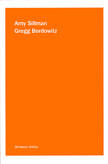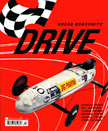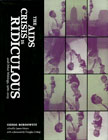
Afterall Books, 2010 (ISBN: 1-846380-65-0)
In the mid-1980s, the Canadian art group General Idea (AA Bronson, Felix Partz and Jorge Zontal) created a symbol using the acronym AIDS, boldly arranging the letters in a manner that resembled Robert Indiana's famous LOVE logo. This launched Imagevirus, a series of paintings, sculptures, videos, posters, exhibitions and ephemera that from 1987 to 1994 used the mechanism of viral transmission to investigate the term AIDS as both word and image.
In this book, artist and writer Gregg Bordowitz analyses Imagevirus from the perspective of his own involvement with activist art initiatives in New York during the 1980s and 90s. Considering the battles fought over sexuality and representation in those years, and through the lens of modernist literature (Gertrude Stein and William S. Burroughs), the author approaches the virus as idea, as tactic and as identity. Bordowitz explores how Imagevirus infected urban spaces across the world, offering a new model for artistic production, one strongly suited to ideological struggle.

Printed Matter, 2009 (ISBN: 9780894390425)
Consisting entirely of questions, Gregg Bordowitz's Volition is 142 pages of active, mind-bending engagement with the reader, who is led down paths of inquiry involving art, meaning, philosophy, choice, happiness, and identity. Bordowitz organizes his questions into lists, paragraphs, and stanzas, which are themselves organized into five chapters: Questions, Topics, Aesthetics, Beliefs, and Morals. The resulting text is something like a spiritual guide crossed with an epic poem crossed with a transcription of the meandering thoughts of a philosophic insomniac, kept awake by such questions as "How can I touch creation as a principle without reproach?" and "How does gratitude unfold from virtue?"

Art Resources Transfer, 2007 (ISBN: 0-923183-41-8)
Over a two-week period between December ‘06 to January ‘07, Amy Sillman and Gregg Bordowitz recorded approximately ten hours of conversation covering topics such as art, philosophy, their practices, their personal histories and their friendship. This edited transcript roughly follows the chronology of their discussions from beginning to end. The transcript starts where they consider the beliefs underlying their respective endeavors, what art can and cannot accomplish.

Whitewalls, 2005 (ISBN: 9780945323013)
Essays by Gregg Bordowitz, Douglas Crimp, Bill Horrigan, Michael Rooks, and Kendall Thomas. Dialogues featuring Gregg Bordowitz with Douglas Crimp, and Gregg Bordowitz with Yvonne Rainer, as well as quoted text from the film Habit. Fiction by Lynne Tillman.
Drive presents a series of essays and texts surrounding Gregg Bordowitz's films Fast Trip, Long Drop and Habit. Images from Bordowitz's installation Drive, exhibited at the Museum of Contemporary Art, Chicago April 6–July 7, 2002, are also featured.
Bordowitz made a big splash in 1993 with Fast Trip, Long Drop. It featured a blend of documentary footage and fictional narrative to focus on his HIV positive diagnosis, the diagnosis of a friend's breast cancer, and the recent deaths of his grandparents. Instead of creating a somber ode to mortality, Bordowitz offered a darkly humorous essay on history, illness, AIDS activism, and representational strategies.
Habit (2002) is the sequel to Fast Trip, Long Drop. It follows the regimens, routines, and thoughts that result from Bordowitz's decade of life as a person with AIDS. Coupled with this are new interviews with some of the same faces featured in Fast Trip, Long Drop, the introduction of new friends and confidants, and extensive footage of AIDS activists in South Africa fighting and organizing to gain access to the same drugs that are keeping Bordowitz and many of his friends alive. The tone of this film is slower from the earlier one, reflecting a change in the tenor of AIDS activism, the fact that South Africa 2001 is not New York 1992, and the new domesticity and responsibility that governs Bordowitz's life today.
For the book, Bordowitz assembled a collection of authors whose views on AIDS and/or aesthetics he greatly respects. Topics range from critical assessments of his films, to the moralizing tenor found in popular images of homosexuality and AIDS, the current state of the aesthetic avant-garde, political activism, race and its complicated relation to sexuality and public policy, living with illness, and a short fiction work on the mental space of illness.

MIT Press, 2004 (ISBN-10: 0-262-52459-7)
The HIV epidemic animates this collection of essays by a noted artist, writer, and activist. "So total was the burden of illness—mine and others'—that the only viable response, other than to cease making art entirely, was to adjust to the gravity of the predicament by using the crisis as a lens," writes Gregg Bordowitz, a film- and video-maker whose best-known works, Fast Trip Long Drop (1993) and Habit (2001), address AIDS globally and personally. In The AIDS Crisis Is Ridiculous—the title essay is inspired by Charles Ludlam, founder of the Ridiculous Theater Company—Bordowitz follows in the tradition of artist-writers Robert Smithson and Yvonne Rainer by making writing an integral part of an artistic practice.
Bordowitz has left his earliest writings for the most part unchanged—to preserve, he says, "both the youthful exuberance and the palpable sense of fear" created by the early days of the AIDS crisis. After these early essays, the writing becomes more experimental, sometimes mixing fiction and fact; included here is a selection of Bordowitz's columns from the journal Documents, "New York Was Yesterday." Finally, in his newest essays he reformulates early themes, and, in "My Postmodernism" (written for Artforum's fortieth anniversary issue) and "More Operative Assumptions" (written especially for this book), he reexamines the underlying ideas of his practice and sums up his theoretical concerns.
In his mature work, Bordowitz seeks to join the subjective—the experience of having a disease—and the objective—the fact of the disease as a global problem. He believes that this conjunction is necessary for understanding and fighting the crisis. "If it can be written," he says, "then it can be realized."